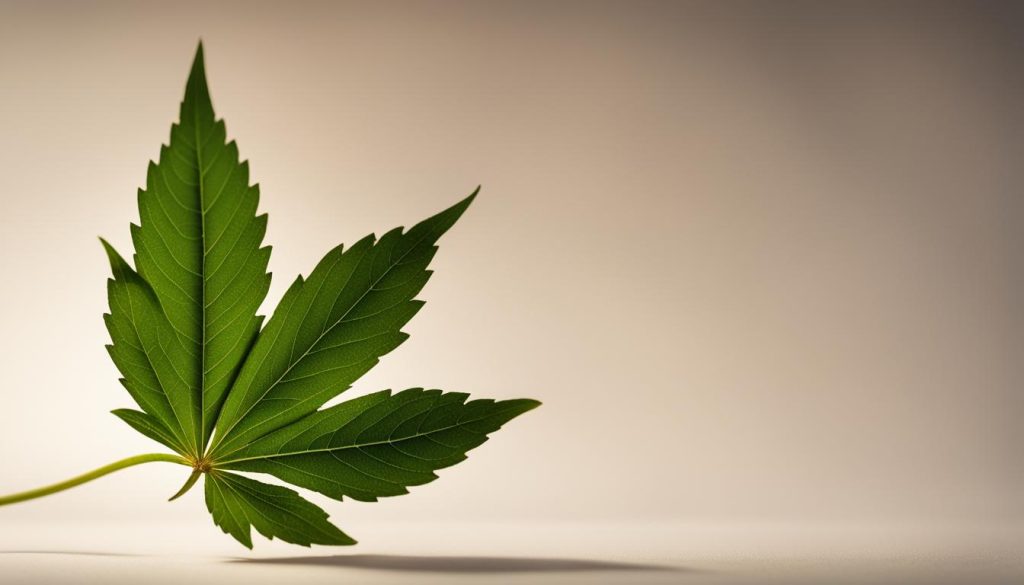
Welcome to our comprehensive guide on the excretion rate of THC and how long it remains detectable in the body after smoking a joint. As THC is the psychoactive component of cannabis, its presence in bodily fluids is often tested to determine recent cannabis use. In this article, we will explore the detection window of THC in urine, as well as other important factors related to drug testing and excretion.
Key Takeaways:
- THC can be detected in urine for a longer period compared to blood or saliva tests.
- The detection window for THC in urine ranges from 1 to 90 days, depending on factors such as dose, frequency of use, and the type of drug test employed.
- The excretion of THC and its metabolites is influenced by factors such as body fat levels and the presence of other substances in the body.
- There are no foolproof methods to speed up THC elimination, but a healthy lifestyle, including exercise, balanced diet, and hydration, may support the natural detoxification process.
- It’s important to be aware of the immediate and long-term effects of cannabis use on physical and mental health, as well as the potential risks and consequences associated with it.
Cannabis Metabolites and Their Elimination from the Body
Cannabis metabolites, including THC, are fat-soluble and bind to fat molecules in the body. This means that they take longer to be eliminated, especially in individuals with higher levels of body fat. THC and its metabolites are eventually excreted in urine and stool. The more THC metabolites present in the body, the longer the elimination process takes.
When THC is ingested or inhaled, it enters the bloodstream and is distributed throughout the body. It is then absorbed by fatty tissues, where it can remain stored for an extended period. The fat-solubility of THC allows it to be slowly released over time, leading to a prolonged detection window in urine and stool tests.
To better understand the process of metabolite elimination, it’s important to consider the body’s natural detoxification mechanisms. The liver plays a crucial role in metabolizing THC into its inactive forms, which are then eliminated through urine and feces. This process can take several days to weeks, depending on the individual’s metabolism and the amount of THC consumed.
| THC Metabolites | Elimination Route |
|---|---|
| 11-OH-THC | Urine, feces |
| THCCOOH | Urine, feces |
| THC-COOH-glucuronide | Urine |
It’s important to note that while THC metabolites can be detected in urine and stool for an extended period, the presence of these metabolites does not necessarily indicate recent cannabis use. Urine and stool tests detect the remnants of THC that have been processed by the body over time, rather than detecting the active presence of THC.
Detection Time for Different Cannabis Drug Tests
When it comes to detecting cannabis use, various drug tests are available, each with its own detection window. The most common method is urine testing, which can detect cannabis use within a specific timeframe. Blood tests, saliva tests, and hair tests are also used to determine recent or long-term cannabis use.
Urine Test
Urine tests are the most commonly used method for detecting cannabis use. They can detect the presence of THC metabolites in urine samples. The detection window for a urine test typically ranges from 3 days for occasional use to more than 30 days for chronic heavy use. However, it’s important to note that individual factors, such as metabolism and body fat percentage, can impact the detection time.
Blood Test
Blood tests are often used to detect recent cannabis use. THC can be detected in the blood within a few hours after use and can remain detectable for up to 2 to 12 hours. Blood tests are more commonly used in situations where immediate impairment needs to be assessed, such as in cases of suspected driving under the influence.
Saliva Test
Saliva tests are another method used to detect recent cannabis use. They have a shorter detection window compared to urine and blood tests. Saliva tests can typically detect cannabis use within the last 24 to 48 hours, making them useful for detecting recent use or impairment.
Hair Test
Hair tests are considered the most sensitive method for detecting cannabis use, with the longest detection window. THC metabolites can be detected in hair samples for up to 90 days after use. Hair tests are often used in situations where a long-term history of cannabis use needs to be determined.
The choice of drug test depends on various factors, including the purpose of the test, the desired detection window, and the specific requirements of the testing organization or institution. It’s important to consider these factors when determining the appropriate drug test for cannabis detection.
Metabolism and Breakdown of THC in the Body
When it comes to the metabolism and breakdown of THC in the body, the liver plays a crucial role. After smoking or ingesting cannabis, THC is absorbed into the bloodstream and transported to various organs and fatty tissues. Once in the liver, THC is metabolized into different compounds, known as metabolites. These include 11-OH-THC and THCCOOH.
The liver’s enzymatic processes break down THC into these metabolites, which are then further broken down into smaller molecules. Eventually, these metabolites are eliminated from the body through different routes, primarily urine and stool. This is why drug tests often look for these metabolites rather than THC itself, as they are evidence of cannabis use.
The breakdown of THC and its metabolites can take time, depending on factors such as dosage, frequency of cannabis use, and individual metabolism. While some metabolites are quickly eliminated, others can linger in the body for longer periods. It’s important to note that the presence of THC and its metabolites in bodily fluids does not necessarily indicate impairment at the time of testing, as they can remain in the body even after the psychoactive effects of cannabis have worn off.
A comprehensive understanding of THC metabolism is essential for accurately interpreting drug test results and determining recent cannabis use. By analyzing the presence and concentration of THC metabolites in urine or stool, drug testing laboratories can provide valuable information about an individual’s cannabis consumption patterns and the potential effects on their health and well-being.
Factors Affecting THC Detection Time
When it comes to detecting THC in the body, there are several factors that can influence the length of time it remains detectable. These factors include the cannabis dose, frequency of use, route of administration, and potency.
The cannabis dose refers to the amount of cannabis consumed in a single session. Generally, higher doses of cannabis are associated with longer detection times. This is because higher doses result in higher levels of THC and its metabolites in the body, which take longer to be eliminated.
The frequency of cannabis use also plays a role in detection time. Individuals who use cannabis more frequently are likely to have higher levels of THC and its metabolites in their system, leading to longer detection windows compared to occasional users.
The route of administration refers to how cannabis is consumed. Smoking or vaping cannabis generally results in faster absorption and elimination compared to ingesting cannabis through edibles. This is because the cannabinoids are absorbed directly into the bloodstream through the lungs, bypassing the digestive system.
The potency of cannabis can also influence detection time. More potent strains of cannabis contain higher levels of THC, which can take longer to be eliminated from the body compared to less potent strains.
| Factors | Affect on THC Detection Time |
|---|---|
| Cannabis Dose | Higher doses are associated with longer detection times |
| Frequency of Use | More frequent use can lead to longer detection windows |
| Route of Administration | Smoking or vaping cannabis results in faster absorption and elimination |
| Potency | More potent cannabis takes longer to be eliminated from the body |
It’s important to note that these factors can vary from person to person and may interact with each other. Additionally, individual metabolism and other unique physiological factors can also play a role in THC detection time.

Summary:
- The cannabis dose, frequency of use, route of administration, and potency can all affect the detection time of THC in the body.
- Higher doses and more frequent use are associated with longer detection windows.
- Smoking or vaping cannabis results in faster absorption and elimination compared to ingesting cannabis.
- More potent strains of cannabis take longer to be eliminated from the body.
Speeding Up THC Elimination
When it comes to eliminating THC from the body, there is no guaranteed method to speed up the process. However, adopting a healthy lifestyle can potentially support the body’s natural detoxification mechanisms. This includes engaging in regular exercise, maintaining a balanced diet, and ensuring proper hydration.
Regular exercise can help stimulate the metabolism and promote the breakdown of fat cells, where THC is stored. It can also enhance circulation, allowing for the faster removal of THC and its metabolites from the body. Additionally, engaging in physical activity can contribute to overall wellness and help manage stress, which may indirectly aid in the detoxification process.
A balanced diet rich in essential nutrients can further support the body’s natural detoxification abilities. Consuming foods that are high in antioxidants, such as fruits and vegetables, can help neutralize and eliminate harmful substances. Including fiber-rich foods, like whole grains and legumes, can also promote healthy digestion and regular bowel movements, aiding in the excretion of THC metabolites.

Expert Tip
“While it’s important to adopt healthy habits, it’s crucial to note that quick fixes and detox remedies marketed online are not reliable and could be potentially harmful. It’s best to rely on natural processes and give your body time to eliminate THC naturally.”
Hydration is another key aspect of supporting the body’s detoxification process. Drinking an adequate amount of water can help flush out toxins, including THC metabolites, through urine. Staying hydrated also promotes healthy kidney function, which plays a vital role in filtering waste products from the blood.
In summary, while there is no foolproof method to speed up THC elimination, maintaining a healthy lifestyle that includes regular exercise, a balanced diet, and proper hydration may support the body’s natural detoxification process. It’s important to approach detoxification with caution and avoid relying on untested remedies or products that claim to provide quick results.
Immediate and Short-Term Effects of Cannabis Use
When cannabis is consumed, it produces immediate and short-term effects due to its psychoactive component, delta-9-tetrahydrocannabinol (THC). These effects can vary depending on factors such as the potency of the cannabis, the method of consumption, and the individual’s tolerance. It’s important to understand the potential impact on our physical and mental well-being.
One of the most commonly reported effects of cannabis use is altered senses. Cannabis can enhance sensory perception, leading to changes in how we perceive colors, sounds, and tastes. Many users also experience mood changes, with some feeling relaxed and euphoric, while others may become anxious or paranoid.
Another notable effect of cannabis use is impaired memory and cognitive function. THC can affect the areas of the brain responsible for memory formation and retrieval, making it difficult to recall recent events or retain new information. This can have a significant impact on daily activities and tasks that require concentration and focus.
“The psychoactive effects of cannabis can vary greatly from person to person, and even from one strain to another. It’s important to be aware of the potential risks and to use cannabis responsibly.”
Long-Term Effects and Risks of Cannabis Use
When it comes to long-term cannabis use, there are several potential risks and effects to be aware of. These include cognitive impairments, cardiovascular diseases, respiratory illnesses, and mood disorders.
One of the concerning aspects of chronic cannabis use is the impact it can have on cognitive function. Research has shown that long-term use may lead to difficulties with memory, attention, and learning. These cognitive impairments can have a significant impact on daily life and may persist even after cannabis use has ceased.
Another area of concern is the potential link between cannabis use and cardiovascular diseases. Studies have suggested that regular cannabis use may increase the risk of conditions such as heart disease, stroke, and heart attacks. The exact mechanisms behind this association are not yet fully understood, but it highlights the importance of considering the cardiovascular health implications of cannabis use.
Respiratory health is also a significant consideration for long-term cannabis users. Smoking cannabis can be harmful to the respiratory system, leading to lung irritation, chronic bronchitis, and an increased risk of respiratory infections. These risks are similar to those associated with tobacco smoke, emphasizing the importance of understanding the potential respiratory consequences of cannabis use.
In addition to cognitive and respiratory effects, mood disorders can also be a potential outcome of long-term cannabis use. Research has suggested a correlation between cannabis use and an increased risk of depression and anxiety disorders. While the exact relationship between cannabis and mood disorders is complex, it is essential to consider the potential mental health implications of long-term use.
| Long-Term Effects of Cannabis Use | Risks |
|---|---|
| Cognitive impairments | Difficulties with memory, attention, and learning |
| Cardiovascular diseases | Increased risk of heart disease, stroke, and heart attacks |
| Respiratory illnesses | Lung irritation, chronic bronchitis, increased risk of respiratory infections |
| Mood disorders | Correlation with increased risk of depression and anxiety disorders |
It’s important to note that the long-term effects of cannabis use can vary from individual to individual, and more research is needed to fully understand the extent of these risks. However, it is crucial to be informed about the potential consequences associated with long-term cannabis use and make informed decisions regarding its use.

Duration of Cannabis Effects
When it comes to the effects of cannabis, the onset and duration can vary depending on several factors. The psychoactive component in cannabis, known as THC, is responsible for producing the desired effects that users seek. The onset of effects can be almost immediate after smoking, typically within a few minutes, while ingestion of cannabis in the form of edibles or capsules may take longer, usually 1-3 hours for the effects to peak.
The duration of cannabis effects also varies depending on factors such as the dose, potency, and individual metabolism. Generally, the effects can last for a few hours, but it’s important to note that individual experiences may differ. Some users may find that the effects wear off relatively quickly, while others may have a longer duration of the high.
It’s worth mentioning that the duration of the psychoactive effects is not necessarily an indicator of how long THC stays in the body. While the effects may dissipate after a few hours, traces of THC and its metabolites can remain detectable in bodily fluids for much longer periods, depending on the type of drug test employed.
| Factors Affecting Duration of Cannabis Effects | Effect on Duration |
|---|---|
| Dose | A higher dose of cannabis may lead to a longer duration of effects. |
| Potency | More potent cannabis strains may result in a longer-lasting high. |
| Metabolism | Individual variations in metabolism can affect how quickly the body processes and eliminates THC. |
| Mode of Administration | Smoking, vaping, or ingesting cannabis can affect the speed at which the effects are felt and their duration. |
It’s important to understand that the effects of cannabis can vary from person to person, and it’s always recommended to use cannabis responsibly and in accordance with local laws and regulations.

Conclusion
In conclusion, the detection and elimination of THC and its metabolites in the body are influenced by various factors. The dose and frequency of cannabis use, as well as the type of drug test employed, play a significant role in the detection window of THC. It is important to note that urine and hair tests have a longer detection window compared to blood and saliva tests.
Additionally, the effects of cannabis use can have both immediate and long-term impacts on physical and mental health. Immediate effects may include altered senses, mood changes, impaired memory, and decreased coordination. Long-term use of cannabis may increase the risk of cognitive impairments, cardiovascular diseases, respiratory illnesses, and mood disorders.
To support the natural elimination process of THC from the body, maintaining a healthy lifestyle is crucial. Regular exercise, a balanced diet, and proper hydration can contribute to overall well-being. It is worth noting that online detox remedies and kits are unreliable and potentially harmful.
Understanding the potential risks and consequences associated with cannabis use is vital for making informed decisions. By considering the factors affecting THC detection and elimination and being aware of the effects of cannabis use, individuals can prioritize their health and well-being.
FAQ
How long does THC stay in your system after smoking a joint?
THC can be detected in blood or saliva within 2-24 hours after use. However, urine and hair tests can detect cannabis use for a longer period, ranging from 1-90 days.
How are THC and its metabolites eliminated from the body?
THC and its metabolites are excreted in urine and stool. They are fat-soluble and bind to fat molecules in the body, which means they take longer to be eliminated, especially in individuals with higher levels of body fat.
What is the detection window for different cannabis drug tests?
Urine tests are the most common method and can detect cannabis use for 3 days for a single use and more than 30 days for chronic heavy use. Blood tests detect recent cannabis use within the last 2-12 hours. Saliva tests have a short detection window, typically detecting same-day cannabis use. Hair tests can detect cannabis use for up to 90 days.
How is THC metabolized and broken down in the body?
After smoking or ingesting cannabis, THC is absorbed into the bloodstream and stored in various organs and fatty tissues. It is then metabolized by the liver into metabolites, such as 11-OH-THC and THCCOOH, before being excreted in urine and stool.
What factors can affect THC detection time?
Several factors can influence how long THC and its metabolites stay in the body, including the dose, frequency of use, and the potency of cannabis. The route of administration, such as smoking or ingesting, can also affect detection times.
Can THC elimination be sped up?
There is no foolproof method to speed up the elimination of THC from the body. However, maintaining a healthy lifestyle, including regular exercise, a balanced diet, and proper hydration, may support the body’s natural detoxification process. Detox remedies and kits available online are not reliable and can be dangerous.
What are the immediate and short-term effects of cannabis use?
Cannabis use can produce immediate effects, such as altered senses, changes in mood, difficulty with thinking and problem-solving, impaired memory, anxiety, confusion, decreased coordination, dry mouth and eyes, increased appetite, and rapid heart rate. In rare cases, high doses of cannabis can lead to hallucinations and acute psychosis.
What are the long-term effects and risks of cannabis use?
Long-term cannabis use may increase the risk of cognitive impairments, cardiovascular diseases, respiratory illnesses, and mood disorders such as depression and anxiety. Using cannabis during pregnancy can negatively affect fetal growth and development. The long-term effects of chronic cannabis use can vary and may be permanent.
How long do the effects of cannabis last?
The effects of cannabis can be felt almost immediately after smoking and can last for a few hours. When cannabis is ingested, it may take 1-3 hours for the effects to peak. The duration of the effects depends on factors such as the dose, potency, and individual metabolism.
What should I know about THC detection and elimination?
The detection and elimination of THC and its metabolites vary depending on factors such as dose, frequency of use, and the type of drug test employed. Cannabis use can have immediate and long-term effects on various aspects of physical and mental health. It’s important to understand the potential risks and consequences associated with cannabis use.
















